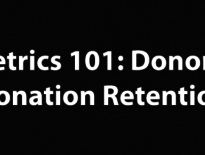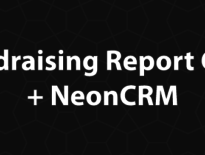Over the past two weeks I sat in on about a half dozen, “How to optimize your year end fundraising” webinars. My oh my, do those things get old quickly. If you’re interested in vaguely outlined concepts that may or may not apply to your organization I’d recommend signing up to attend a few.
Or, if you’re like me—short on time, wearing many hats and constantly digging through the weeds to find actionable content—I’d recommend taking 5 minutes to read this short article.
We’re going to cover 2 super simple tactics that you can actually employ in the next few weeks to boost your year end fundraising. I am a huge advocate of planning, organizing and executing, but in this case “winging it” can actually be acceptable. Except, the thing is we won’t be winging it, we’ll be using data to help guide our decision making.
Okay, enough fluff, here are the 2 tactics we will cover to boost year end fundraising:
- Segment and frame your ask with specific dollar goals
- Reactivate lapsed donors
Year end fundraising is the right time to segment ask amounts
It’s time to leverage the investment your organization made in purchasing Raiser’s Edge or hopefully a more modern CRM. Your database is a gold mine. For-profit companies live by their data. They slice, they dice, and segment beyond belief to make sure that the right message and offer is delivered to the right group of individuals. As nonprofits, we should be doing the same thing.
You can segment your donors into dozens of categories (more on that here), but for now we are going to focus on dollar amounts. Were you already planning on sending out an email appeal to your constituents? Great, let’s optimize it.
Here is what we are going to do:
- Determine your “giving level” segments
- Create a compelling “offer” for each segment
- Create a fundraisingreportcard.com account & export your donor segments
- Upload the segmented lists to your email service provider
This entire process should take less than 30 minutes.
1. Determine your “giving level” segments
Your email campaign should have a variable input field for how much money you will ask each specific donor to donate. To make this effective, we need to break up your list into segmented groups determined by giving levels.
For example, you will want a unique message targeted to all of your donors who have given less than $100. The email might read, “We appreciate your continued support of our mission and vision, and that is why this year we are asking for a one-time contribution of $50 to meet our end of year fundraising goal.”
Another segment might be $100-$250 donors. That message would read, “…we are asking for a one-time contribution of $150 …”
Determine which segments make the most sense for your organization. Through our research at the Fundraising Report Card® we have found that the most frequently used segments are:
- Under $100
- $100 – $250
- $250 – $1000
- $1000 – $5000
- $5000+
2. Create a compelling offer for each segment
I am not a fundraising consultant—I’m a data nerd. But even I recognize that donors like to know where their money is going. For each giving segment you can add variable content to your email to tell the donor exactly how their contribution will be used.
For example if your year end fundraising is targeting $1000 – $5000 donors you might have a message like, “We appreciate your continued support of our mission and vision, and that is why this year we are asking for a one-time contribution of $2500 to meet our end of year fundraising goal. Your contribution at this level will be used to directly support our continued efforts to increase literacy in developing countries. Specifically, your donation will be put towards building a new library in Laos.”
Yet for under $100 donors your message might be, “We appreciate your continued support of our mission and vision, and that is why this year we are asking for a one-time contribution of $50 to meet our end of year fundraising goal. Your contribution at this level will be used to directly support our continued efforts to increase literacy in developing countries. Specifically, your donation will be put towards purchasing 2 dozen books for our recently completed library in Laos.”
3. Create a fundraisingreportcard.com account & export your donor segments
Okay, now that we have our segments and offers in place, here is where the rubber meets the road. You might be saying to yourself, “This idea is great and all, but I have no clue how to segment my donors into these groups.” That’s where the Fundraising Report Card® comes into play.
It’s easy. Just create an account, upload your anonymous donor data and it will export back out your segmented lists for you. Boom. Done. No Excel wizardry needed.
4. Upload the segmented list to your email service provider
Take those exported lists from your fundraisingreportcard.com account and import them to your ESP (email service provider). This might be the trickiest part—if you have someone at your organization who manages your email communications ask them for help, or, use the live-chat on the fundraisingreportcard.com website and they will help.
And there you go, in 4 steps you have created targeted and segmented appeals to optimize your end of year fundraising. Onto strategy number 2.
Year end fundraising should reactivate lapsed donors
The best way to increase donation revenue while minimizing donor acquisition cost is to retain donors. No matter how hard you try, inevitably some donors will lapse and move on to other organizations. That being said, the year end is a great time to target those individuals and get them to come back.
Your appeal can be simple, something along the lines of, “We miss you and want your support again.” This will go a long way and can remind a lapsed donor to come back. Plus, pulling a list of recently lapsed donors is super simple when you use your fundraisingreportcard.com account.
Simply click on the Lapsed report from inside your account and export your data. And there you have your list to be used for this campaign. What’s great is that you’ll be able to see how many individuals actually reactivated by re-uploading your data to your fundraisingreportcard.com account after you send out the appeal.
There you have it! 2 simple tactics that are actually actionable. If you give these techniques a try, let me know. I’m interested to know how they work for you and I’d like to hear about your results!





1 What is our annual rate of growth?
Annual growth rate (both in terms of donors and donations)
2 What is our annual average gift size?
Average gift size
3 How much does a donor donate over the lifetime of their giving?
Donor lifetime value